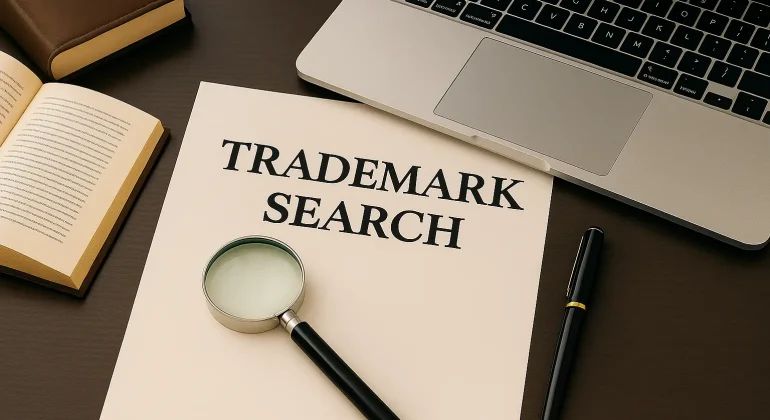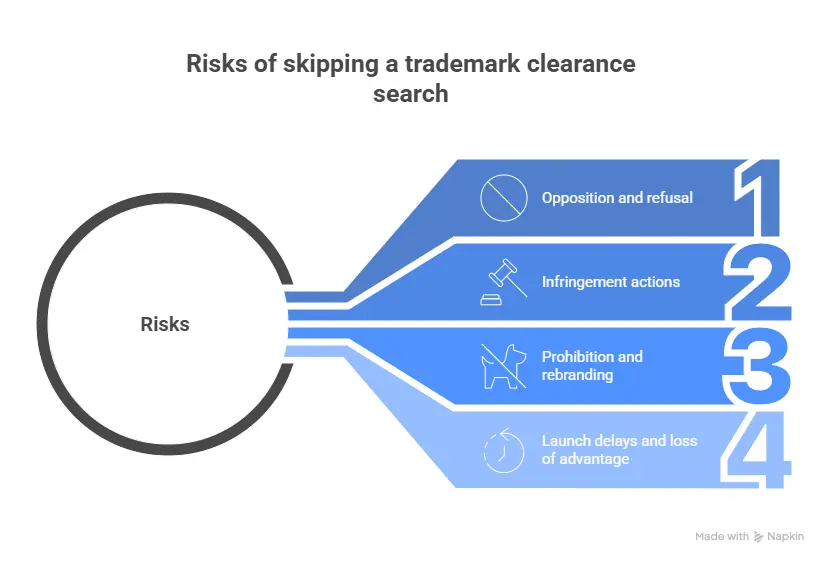Sommaire
Introduction
Before launching a brand, a clearance search is indispensable. It verifies the existence of prior rights (trademarks, trade names, domain names, unregistered uses) that could block registration or prohibit the use of the mark. In France, in the European Union, and more generally worldwide, this verification is the responsibility of the applicant.
Overlooking this step may have serious consequences: opposition proceedings, infringement litigation, or even the obligation to rebrand after considerable marketing investments. Conversely, a well-conducted search not only secures the filing but also anticipates disputes and enables smooth negotiations with prior right holders.
Why is a clearance search indispensable?
Definition and legal imperative (France and the European Union)
A clearance search aims to identify existing signs likely to prevent registration. In France and for EU trademarks, the trademark offices (INPI and EUIPO) do not examine potential conflicts, since this analysis lies with the applicant. In international trademark procedures, WIPO merely transmits the application to the designated offices.
Practical stakes and concrete risks
Without a clearance search, you risk:
- Opposition before the trademark offices once the application is published;
- Cancellation actions after registration;
- Infringement actions with damages once the mark is on the market;
- Prohibition of use and costly rebranding;
- Delayed launches and loss of competitive advantage.
By contrast, a sound search assesses the likelihood of confusion, anticipates objections, and optimises the scope of goods and services.
Comparative frameworks: United States, France and the European Union
An instructive U.S. example: the Huella case (TTAB, May 7, 2025)
In the United States, the USPTO refuses registration where there is a “likelihood of confusion” between signs and the goods and services are related. This is one of the most common grounds for refusal. Indeed, the USPTO carries out its own clearance search during examination.
In the Huella case of 7 May 2025, the registration of a mark for leather bags (Class 18) was refused because of an earlier registration for cosmetics (Class 3). The Board found:
- extensive evidence of cross-use by third-party brands (cosmetics and bags marketed under the same mark);
- an inherent connection, since leather bags includes cosmetic cases;
- no limitations on distribution channels in the identification, which implied overlapping trade channels and consumer bases.
The refusal was therefore upheld. Even if classes differ, goods may still be deemed related. A clearance search must therefore cover not only the intended classes but also related ones, taking into account distribution channels.
French and European references (INPI, EUIPO, WIPO)
In France, searches rely on INPI’s database; at the EU level, on EUIPO; for global strategy, WIPO is essential. These tools help identify prior signs, but interpretation always requires legal expertise, considering confusion risks, market practice, and possible notoriety of existing marks. Engaging a specialist is strongly advised, as practitioners have access to enhanced databases and can deliver an optimal risk assessment.
Best practices for comprehensive and strategic searches
Key steps not to be overlooked
- Define precisely the sign to be protected (word mark, logo, variations).
- Identify relevant classes and related classes under the Nice Classification.
- Conduct searches among registered trademarks in France, the EU, and, if expansion is envisaged, in the U.S. and other countries of manufacture, marketing, or projection.
- Review the results with legal analysis (visual, phonetic, conceptual)while considering recent case law.
- Assess the likelihood of confusion in light of goods and services and the relevant public.
- Determine the appropriate strategy: filing, adapting the mark, coexistence agreement, or abandoning the project.
Complementary searches to be conducted simultaneously
Beyond registered trademarks, it is vital to check:
- Corporate names and trade names (Infogreffe, SIRENE).
- Domain names and use on social networks.
- Copyrights and/or designs.
These elements may present legal obstacles just as serious as a registered trademark.
Conclusion and call to action
A clearance search is the first safeguard against legal uncertainty. It enables confident investment, avoids costly disputes, and strengthens brand strategy. This indispensable step requires the expertise of a professional able to “read between the lines” and measure the commercial impact of existing signs.
Dreyfus & Associés works in partnership with a global network of intellectual property attorneys.
Nathalie Dreyfus with the support of the entire Dreyfus team
FAQ
How does a clearance search differ from a simple Google search?
An online search does not cover official registers and cannot assess legal risk. INPI, EUIPO, and WIPO databases are indispensable. Legal expertise is required to interpret results and to propose a clearance strategy if conflicts arise.
Is a search mandatory before filing?
No, but it is strongly recommended: failing to conduct one transfers the entire legal risk to the applicant and creates a permanent threat. At any time—even years after launch—you may face infringement claims and substantial damages. Moreover, rebranding costs after years of investment may be enormous.
Do searches limited to the exact class of goods/services suffice to avoid conflicts?
Not always. Case law shows that market connections (e.g. fashion and cosmetics) can establish a likelihood of confusion. This is why the involvement of an IP specialist is essential to determine the appropriate scope of the search.
Can a mark be filed despite a similar prior right?
Yes, provided that consent is obtained, a coexistence agreement is signed, or the goods/services are restricted.
Can an unregistered mark block an application?
Yes. If it is well-known or significantly used, it can be opposed to a filing in France. In addition, “common law” rights may arise through use, notably in the United Kingdom, the United States, and Canada.


